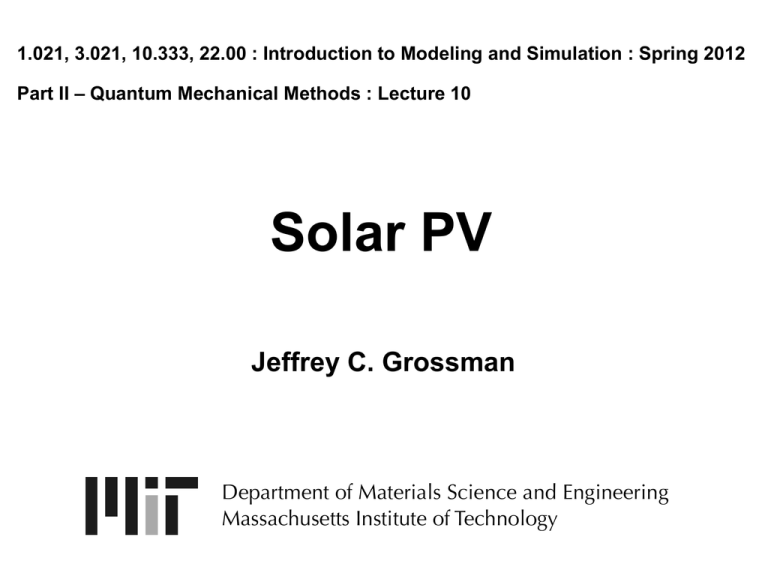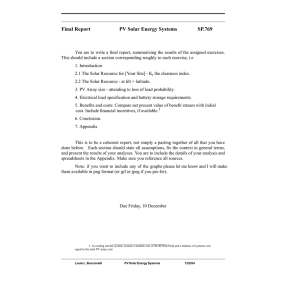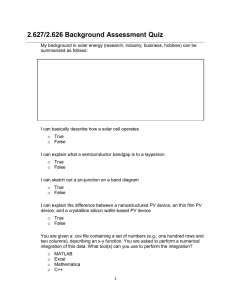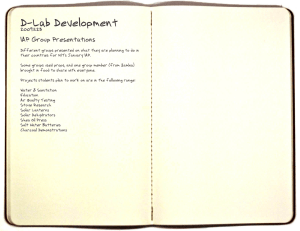
1.021, 3.021, 10.333, 22.00 : Introduction to Modeling and Simulation : Spring 2012
Part II – Quantum Mechanical Methods : Lecture 10
Solar PV
Jeffrey C. Grossman
Department of Materials Science and Engineering
Massachusetts Institute of Technology
Part II Topics
1.
2.
3.
4.
5.
6.
7.
8.
9.
10.
11.
It’s a Quantum World:The Theory of Quantum Mechanics
Quantum Mechanics: Practice Makes Perfect
From Many-Body to Single-Particle; Quantum Modeling of Molecules
Application of Quantum Modeling of Molecules: Solar Thermal Fuels
Application of Quantum Modeling of Molecules: Hydrogen Storage
From Atoms to Solids
Quantum Modeling of Solids: Basic Properties
Advanced Prop. of Materials:What else can we do?
Application of Quantum Modeling of Solids: Solar Cells Part I
Application of Quantum Modeling of Solids: Solar Cells Part II
Application of Quantum Modeling of Solids: Nanotechnology
Summary
•
• Solar PV - More Motivation
• Solar PV - the viewpoint of the
A bit of discussion of PSET 6
electron!
•
How computational quantum
mechanics can impact solar PV
Energy from the Sun
• Energy released by an earthquake of
magnitude 8 (1017 J):
• the sun delivers this in one second
• Energy humans use annually (1020 J):
• sun delivers this in one hour
• Earth’s total resources of oil (3
trillion barrels, 1022 J):
• the sun delivers this in two days
Courtesy of SOHO/EIT (ESA & NASA) consortium.
Time Magazine, 3 April 2006
© Time Magazine. All rights reserved. This content is excluded from our Creative
Commons license. For more information, see http://ocw.mit.edu/help/faq-fair-use/.
Cost of Inaction?
Image by Dr. Pieter Tans, NOAA/ESRL and Dr. Ralph
Keeling, Scripps Institute of Oceanography.
Grinnel Glacier: 1910 photo by Fred Kiser (top); 1997 photo by Dan Fagre (bottom). Courtesy of GNP archives.
Warming is Real and Has Real Effects
Jan 31
Feb 23
MODIS images from NASA's Terra satellite courtesy of Ted Scambos,
National Snow and Ice Data Center, University of Colorado, Boulder.
Feb 17
Mar 5
Between Jan 31, 2002
and March 5, 2002 a
chunk of the Larsen
B ice shelf the size of
Rhode Island
disintegrated.
Images from NASA's
Terra satellite,
National Snow and
Ice Data Center,
University of
Colorado, Boulder.
Surveys show the mountain pine beetle has infested
21 million acres and killed 411 million cubic feet of
trees -- double the annual take by all the loggers in
Canada. In seven years or sooner, the Forest Service
predicts, that kill will nearly triple and 80 percent of
the pines in the central British Columbia forest will
be dead.
The Washington Post, March 1, 2006
Photo by Leo Rankin/British Columbia Forest Service. All rights reserved. This content is excluded from
our Creative Commons license. For more information, see http://ocw.mit.edu/help/faq-fair-use/.
CO2 Projections
Source: Climate Change 2007: The Physical Science Basis. Contribution of
Working Group I to the Fourth Assessment Report of the Intergovernmental
Panel on Climate Change
Climate Change 2007: The Physical Science Basis. Working Group I Contribution to the Fourth Assessment
Report of the Intergovernmental Panel on Climate Change, Figure 10.22 (b). Cambridge University Press.
The seesaw pattern that rides the rising CO2 trend
results from the annual “breathing” of the earth.
Nature “borrow[s] CO2 for plant growth during the
summer and return[s] the loan each succeeding winter.”
– David Keeling
Recent world events that
slowed oil production
Image by Dr. Pieter Tans, NOAA/ESRL and Dr. Ralph Keeling, Scripps Institute of Oceanography.
Science 310, 1313 (2005)
Temperature inferred from isotope
ratios in the Vostok ice core
Carbon dioxide levels measured in
the trapped air bubbles in the
same core
Photo by Lonnie Thompson, Courtesy of Ohio
State University. All rights reserved.
from Thin Ice by Mark Bowen
CO2 twice as high
as it has ever been
in 400,000 YEARS
© source unknown. All rights reserved.
Copyrighted material on this page is excluded from our Creative Commons license. For more information, see http://ocw.mit.edu/help/faq-fair-use/.
“I can get eight professors from MIT on
both sides of this issue and no one in this
room will walk away understanding what
they said about climate change.” ! Charlie Baker, Former Candidate for
Massachusetts Governor
© unknown. All rights reserved. This content is excluded
from our Creative Commons license. For more information,
see http://ocw.mit.edu/help/faq-fair-use/.
If warming exceeds 2°C, negative effects increase
and catastrophic changes become more likely
Courtesy of Hal Harvey. Used with permission.
Courtesy: Hal Harvey (Climate Works)
Abundance of Solar Energy
Average solar power incident on Earth ~ 130,000 TW
Global energy consumption (2001) ~ 13.5 TW
Source: DOE
24%
23%
6.7%
6.5%
0.75%
39%
ENERGY SOURCES
Petroleum
Natural Gas
Coal
Hydroelectricity
Nuclear
Solar/Wind/Wood/Waste
If ~2% of the continental United States is covered with PV systems with
a net efficiency of 10% we would be able to supply all the US energy
needs (0.3% land coverage to meet just electricity needs)
(Land area requirement is comparable to area occupied by interstate highways)
Note: 40% of our land is allocated to producing food
Nuclear power equivalent is 3,300 x 1 GW nuclear power plants.
(1 for every 10 miles of coastline or major waterway)
Solar Across Scales
Moscone Center: 675,000 W
Residential home: 2400 W
Kenyan PV market:
Average system: 18W
Moscone Center © SunPower/PowerLight Corp. Image of residential roof and Kenyan woman with panel © unknown. All rights reserved.
This content is excluded from our Creative Commons license. For more information, see http://ocw.mit.edu/help/faq-fair-use/.
Solar Land Area Requirements
150 Km2 solar panels in
Nevada would power
the U.S. (15% efficient)
J.A.Turner, Science 285
1999, p. 687.
Image by the United States Geological Survey is in the public domain.
Solar Land Area Requirements
for ~20TW
2
At a price (today) of $350/m
à this would cost $50 trillion!
Image by Matthias Loster on Wikimedia Commons. License: CC-BY.
Solar PV: Grid Parity
Source: Mckinsey
Lorenz, P., D. Pinner, and T. Seitz. "The Economics of Solar Power." Energy, Resources, Materials: McKinsey & Company, June 2008. All rights
reserved. This content is excluded from our Creative Commons license. For more information, see http://ocw.mit.edu/help/faq-fair-use/.
Aim: capture 10% of electrical genera;on with PV
14¢
Side note: replacing fossil fuels in the developing world will become much more important in the near future.
At 14¢ per kWeh, PV could cost-effectively replace 10%
of electrical energy used in U.S.
No storage needed.
Could be deployed by 2022, with 0.04% land use.
SOLAR INTENSITY:
HOW MUCH AREA IS REQUIRED TO GENERATE POWER?
sun
Satellite
air mass 1
air mass 1.5
atmosphere
earth
sun
Solar spectrum outside atmosphere:
air mass 0 (AM0) 1353 W/m2
At earth’s surface: sun at zenith: air mass 1 (AM1) 925 W/m2
sun at 45°: air mass 1.5 (AM1.5) 844 W/m2
AM1.5 is terrestrial solar cell standard
Comparison of PV Technologies
We are here, e.g.,
• amorphous silicon
• polymers
• all-carbon
• quantum dots
This image is in the public domain. Source: Wikimedia Commons.
Solar PV technology landscape (2015)
• Cost/efficiency tradeoff:
• high efficiency modules
have lower installation
costs
• low efficiency modules
have lower module costs
module efficiency:
7%
15.4%
9.1%
12.2%
13.2%
Installation cost {$/W}
2.6
2.2
Cost
savings
1.8
1.4
8
12
16
20
Module efficiency {%}
Image by MIT OpenCourseWare.
© source unknown. All rights reserved. This content is excluded from our Creative
Commons license. For more information, see http://ocw.mit.edu/fairuse.
How do we supply 81 kWh/day/
person of solar electricity?
105
Annual PV production in GW
14,000 acres/day
4
10
100% US
3
10
10% US
102
10
1
14 acres/day
0.1
2000
2010
2020
2030
2040
Year
Expected Global Solar Cell Production.
After Mike Rogol.
Image by MIT OpenCourseWare.
2006: Solar Cell Production Rate: 14 acres / day
2035: Required Solar Cell Production Rate: 14,000 acres / day
To survive, any new technology needs to:
- ACCELEREATE OVER THE Si-PRODUCTION
- REACH HIGHER EFFICIENCIES and/or LOWER INSTALLATION COSTS
PN Junc;on (brief review)
Equilibrium in a p-n junction is still “dynamic” and there are four kinds of currents contributing to the net
zero flow of charge.
(1)Majority Hole Current. Diffusional current from hole movement from p to n (current from p to n).
(2)Minority Hole Current. Drift current from holes moving from n to p, assisted by the electric field
(current from n to p).
(3)Majority Electron Current. Electron diffusion from n to p from the high concentration gradient (current
from p to n).
(4)Minority Electron Current. Electron drift from p to n, assisted by the electric field (current from n to p).
In reverse bias (V < 0), the current comes from minority carriers and is due to drift. In forward bias (V >
0), the current arises from majority carriers and is due to diffusion.
PN Junc;on (brief review)
The presence of light induces a net positive change in the generation–recombination rate. Roughly
speaking, for each type of current, the effect of light is:
(1)Majority Hole Current. Relatively unaffected, if generation occurs evenly on both sides.
(2)Minority Hole Current. Increased, due to the additional carriers now present. The additional carriers
resulting from illumination are immediately transferred across the junction in the form of a drift
current.
(3)Majority Electron Current. Relatively unaffected.
(4)Minority Electron Current. Increased, due to the additional carriers now present.
Effectively, under illumination, the IV characteristic of the PN junction is shifted downwards, by an
amount that is directly determined from the photocurrent incident upon the junction.
Fundamental Processes Involved in
Solar Photovoltaics: Electron’s View
Relaxation
Photo-excitation
Extraction
Ef
Transport
CBM
Ef
Extraction
Transport
Recombination
VBM
External Load
The Role of Computational
Quantum Mechanics
• What do we know how to compute?
• How does it help for solar PV?
?
Images of solar panel and strips © sources unknown. All rights reserved.
This content is excluded from our Creative Commons license. For more
information, see http://ocw.mit.edu/help/faq-fair-use/.
elec
t
prop rical
ertie
s
?
?
l
mechanica
properties
?
l
optica
es
i
t
r
e
p
pro
Crystalline Silicon Solar PV
(80% of current market)
• Light Absorption
• Band Gap
• Band Structure
• Electron/Hole Transport
• Electron/Hole Mobilities
© Helmut Föll. All rights reserved. This content is excluded from our Creative
Commons license. For more information, see http://ocw.mit.edu/fairuse.
=e
2
dk
4 3
f
E
v(k)v(k)
Amorphous Silicon Solar PV
(3% of current market)
• Light Absorption (is actually pretty good)
• Electron-Hole Separation (also not a problem)
• Electron/Hole Transport (Holes are Slow!)
• Hole Mobilities
• Hole Traps: from total energy differences
(Eneutral-Echarged)
Organic Solar PV
• Light Absorption (need to capture more of the
solar spectrum)
• Band gap
• Electron-Hole Separation
• Orbital energies
© source unknown. All rights reserved. This content is excluded from our Creative
Commons license. For more information, see http://ocw.mit.edu/help/faq-fair-use/.
Poly(3-hexylthiophene) (P3HT): Eg,exp = 2.1 eV
Low-energy photons are not absorbed!
R
R
Egap = Eo
Egap = 0.55Eo
Egap = 1.1Eo
Dye Sensitized Solar PV
Gratzel and O’Regan
(Nature, 1991)
Made up of 3 active materials:
•Dye absorbs light.
•TiO2 nanoparticles with very
large surface area take electron.
•Liquid electrolyte delivers new
electron from cathode to dye.
www.energyer.com
Image in the public domain. Via M. R. Jones on Wikimedia Commons.
Dye Sensitized Solar PV
• Biggest
problem is a
liquid
electrolyte.
• Relative
energy levels
of TiO2 and
dye also key.
© source unknown. All rights reserved. This content is excluded from our Creative
Commons license. For more information, see http://ocw.mit.edu/help/faq-fair-use/.
Summary
•
• The Sun has a Lot of it For Free but
Energy is a Major Global Challenge
it’s Too Expensive to Utilize
• Computational Quantum Mechanics
can Help us Understand and Predict
PV New Materials
MIT OpenCourseWare
http://ocw.mit.edu
3.021J / 1.021J / 10.333J / 18.361J / 22.00J Introduction to Modelling and Simulation
Spring 2012
For information about citing these materials or our Terms of Use, visit: http://ocw.mit.edu/terms.



